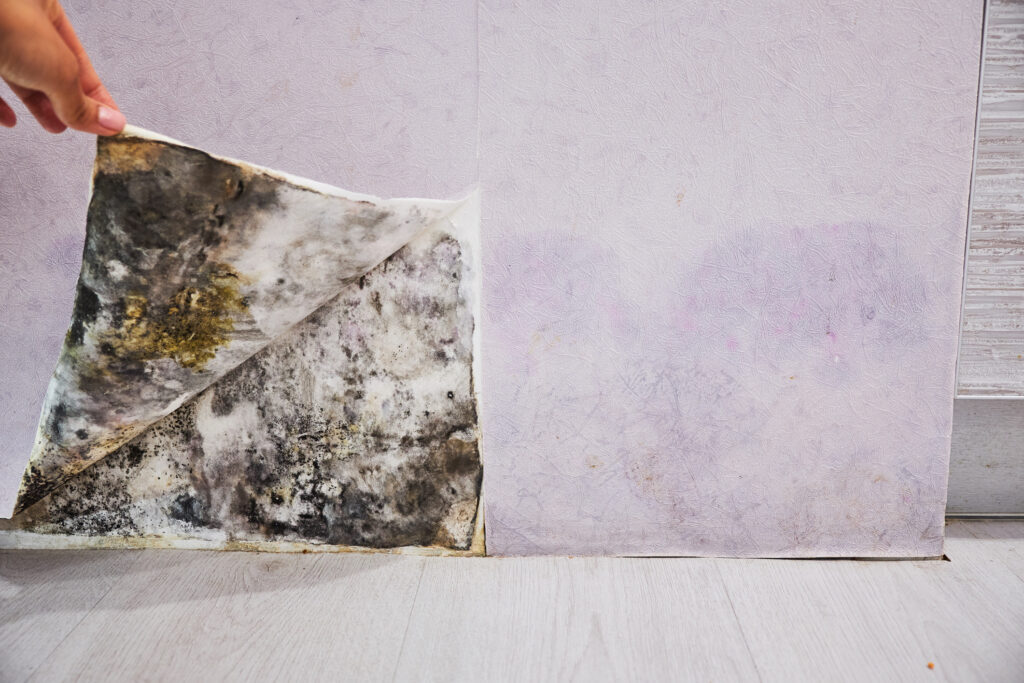Mold is a type of fungus found in damp, shady areas or where vegetation is decomposing. Indoor molds can grow on just about any surface where there is moisture, oxygen, and organic material. When mold is disturbed, it releases spores into the surrounding air.
While people are exposed to mold every day, certain molds are dangerous for our health. It’s important to know the signs of mold in your home and how to protect your family against harmful spores.

Is It Dangerous to Have Mold in Your Home?
Not all molds are dangerous, but certain ones can cause various health issues. These health issues can be worse for individuals who are immuno-compromised or who have chronic respiratory disease. Some people may even have trouble breathing when exposed to mold.
Some other symptoms that stem from mold spore exposure include:
- Skin rashes
- Nasal and sinus congestion
- Eye irritation
- Blurred vision
- Sore throat
- Chronic cough
These symptoms are why it’s important to keep an eye out for mold in your home and have it properly remediated if you find any.
Signs Your Home May Have Mold
It’s important to be aware of the signs that your home may have mold. However, please note that these signs are not foolproof. The best way to determine if you have mold is to use a testing kit or hire professional mold remediation services if you see any of these signs:
- Musty odors: Mold can smell earthy and damp, particularly in areas like basements, bathrooms, or crawl spaces.
- Visible mold growth: Mold will look like green, black, white, or grayish patches on walls, ceilings, and other surfaces. It may appear fuzzy, slimy, or powdery.
- Water damage or stains: Discolored walls or ceilings can indicate water damage, which can form ideal conditions for mold growth. Bubbling wallpaper or paint can also indicate water damage.
- Persistent humidity: If your indoor humidity level is over 60%, mold may grow more easily. If you have condensation on walls, windows, or pipes, your home may have excessive moisture that can help mold grow.
- Increased allergy or respiratory symptoms: You should watch for health symptoms, such as sneezing, coughing, or a runny nose that worsens indoors. Additional symptoms include itchy eyes, skin irritation, throat discomfort, asthma flare-ups, unexplained fatigue, or headaches.
How To Control Mold Issues in Your Home
If you have found mold in your home through a testing kit or professional services, it’s time to control mold and reduce future growth. Here are some ways to deal with mold in your home.
- Scrub with bleach: Using bleach can help remove surface-level mold, but you may need professionals to eradicate the problem.
- Dehumidifiers: Controlling the humidity in your home can help curb mold growth. Keep the humidity under 50% by running a dehumidifier in your basement and use air conditioners in the summer to reduce weather-related humidity.
- Improve your home’s ventilation: Some ways to accomplish this include using exhaust fans in bathrooms and kitchens, opening windows to improve airflow, and ensuring dryers, stoves, and heaters vent outside.
- Prevent water intrusion: Make sure you seal windows and doors with weather stripping and caulking and improve the drainage around your home to prevent rain and snow from getting inside.
- Whole-home air purification: Installing a whole-home air purification system can help trap and capture spores and other pollutants in your home, improving your indoor air quality and making a healthier space. You can also use quality filters in your HVAC systems to help trap dust and other pollutants.
24/7 Emergency Service (224) 757-1647
Call Home Comfort for Air Quality Services
Controlling your home’s humidity and using air purifiers are important ways to help prevent or manage mold and related health problems in your household, in conjunction with working with a professional mold remediator.
Improve your air quality through professional HVAC services by Home Comfort. We have helped families improve the comfort of their homes for over 25 years, and our experienced technicians always provide the best customer service and satisfaction.
Contact Home Comfort today to request professional air quality solutions and services in Northwest Chicagoland.



